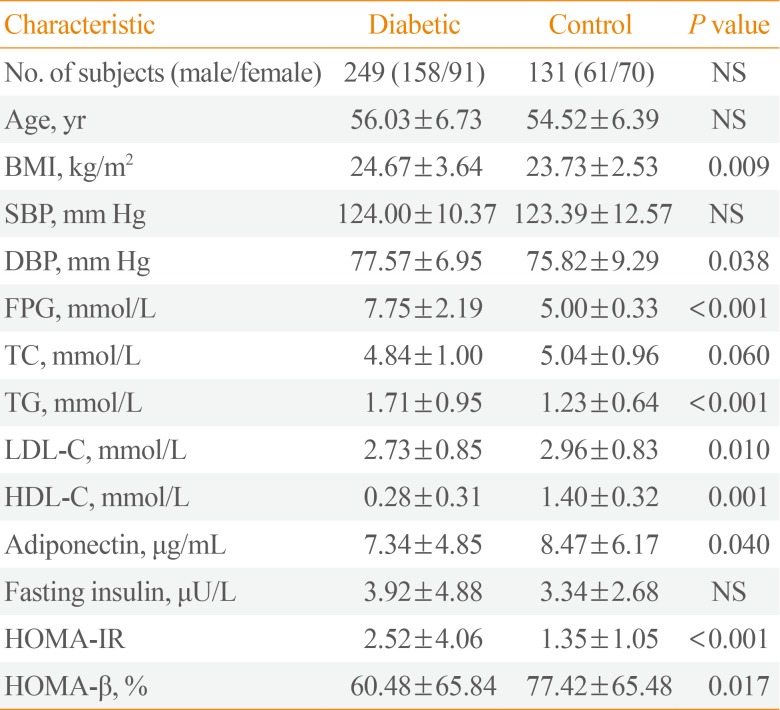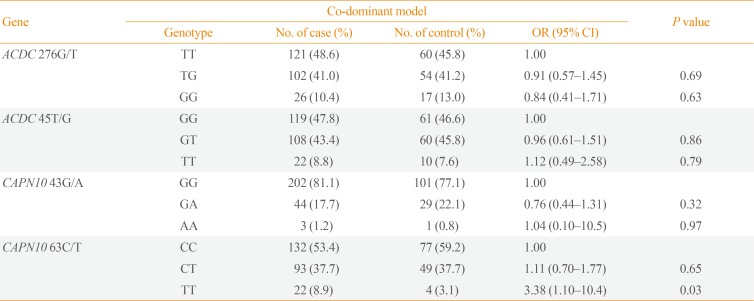1. Kim WY, Kim JE, Choi YJ, Huh KB. Nutritional risk and metabolic syndrome in Korean type 2 diabetes mellitus. Asia Pac J Clin Nutr. 2008; 17(Suppl 1):47–51. PMID:
18296299.
2. Stumvoll M, Goldstein BJ, van Haeften TW. Type 2 diabetes: principles of pathogenesis and therapy. Lancet. 2005; 365:1333–1346. PMID:
15823385.

3. Kifagi C, Makni K, Mnif F, Boudawara M, Hamza N, Rekik N, et al. Association of calpain-10 polymorphisms with type 2 diabetes in the Tunisian population. Diabetes Metab. 2008; 34:273–278. PMID:
18487065.

4. Evans JC, Frayling TM, Cassell PG, Saker PJ, Hitman GA, Walker M, et al. Studies of association between the gene for calpain-10 and type 2 diabetes mellitus in the United Kingdom. Am J Hum Genet. 2001; 69:544–552. PMID:
11481585.

5. Fingerlin TE, Erdos MR, Watanabe RM, Wiles KR, Stringham HM, Mohlke KL, et al. Variation in three single nucleotide polymorphisms in the calpain-10 gene not associated with type 2 diabetes in a large Finnish cohort. Diabetes. 2002; 51:1644–1648. PMID:
11978669.

6. Elbein SC, Chu W, Ren Q, Hemphill C, Schay J, Cox NJ, et al. Role of calpain-10 gene variants in familial type 2 diabetes in Caucasians. J Clin Endocrinol Metab. 2002; 87:650–654. PMID:
11836299.

7. Chandran M, Phillips SA, Ciaraldi T, Henry RR. Adiponectin: more than just another fat cell hormone? Diabetes Care. 2003; 26:2442–2450. PMID:
12882876.

8. Hara K, Boutin P, Mori Y, Tobe K, Dina C, Yasuda K, et al. Genetic variation in the gene encoding adiponectin is associated with an increased risk of type 2 diabetes in the Japanese population. Diabetes. 2002; 51:536–540. PMID:
11812766.

9. Kondo H, Shimomura I, Matsukawa Y, Kumada M, Takahashi M, Matsuda M, et al. Association of adiponectin mutation with type 2 diabetes: a candidate gene for the insulin resistance syndrome. Diabetes. 2002; 51:2325–2328. PMID:
12086969.
10. Song KE, Kim DJ, Park JW, Cho HK, Lee KW, Huh KB. Clinical characteristics of Korean type 2 diabetic patients according to insulin secretion and insulin resistance. J Korean Diabetes Assoc. 2007; 31:123–129.

11. Kim MJ, Yoo KH, Park HS, Chung SM, Jin CJ, Lee Y, et al. Plasma adiponectin and insulin resistance in Korean type 2 diabetes mellitus. Yonsei Med J. 2005; 46:42–50. PMID:
15744804.

12. Lee YY, Lee NS, Cho YM, Moon MK, Jung HS, Park YJ, et al. Genetic association study of adiponectin polymorphisms with risk of type 2 diabetes mellitus in Korean population. Diabet Med. 2005; 22:569–575. PMID:
15842511.

13. Li LL, Kang XL, Ran XJ, Wang Y, Wang CH, Huang L, et al. Associations between 45T/G polymorphism of the adiponectin gene and plasma adiponectin levels with type 2 diabetes. Clin Exp Pharmacol Physiol. 2007; 34:1287–1290. PMID:
17973869.

14. Bacci S, Menzaghi C, Ercolino T, Ma X, Rauseo A, Salvemini L, et al. The +276 G/T single nucleotide polymorphism of the adiponectin gene is associated with coronary artery disease in type 2 diabetic patients. Diabetes Care. 2004; 27:2015–2020. PMID:
15277433.

15. Yang WS, Yang YC, Chen CL, Wu IL, Lu JY, Lu FH, et al. Adiponectin SNP276 is associated with obesity, the metabolic syndrome, and diabetes in the elderly. Am J Clin Nutr. 2007; 86:509–513. PMID:
17684226.

16. Marshall C, Hitman GA, Partridge CJ, Clark A, Ma H, Shearer TR, et al. Evidence that an isoform of calpain-10 is a regulator of exocytosis in pancreatic beta-cells. Mol Endocrinol. 2005; 19:213–224. PMID:
15471947.
17. Horikawa Y. Calpain-10 (NIDDM1) as a susceptibility gene for common type 2 diabetes. Endocr J. 2006; 53:567–576. PMID:
16873988.

18. Song Y, You NC, Hsu YH, Sul J, Wang L, Tinker L, et al. Common genetic variation in calpain-10 gene (CAPN10) and diabetes risk in a multi-ethnic cohort of American postmenopausal women. Hum Mol Genet. 2007; 16:2960–2971. PMID:
17855447.

19. Chen SF, Lu XF, Yan WL, Huang JF, Gu DF. Variations in the calpain-10 gene are associated with the risk of type 2 diabetes and hypertension in northern Han Chinese population. Chin Med J (Engl). 2007; 120:2218–2223. PMID:
18167206.

20. Ezzidi I, Turki A, Messaoudi S, Chaieb M, Kacem M, Al-Khateeb GM, et al. Common polymorphisms of calpain-10 and the risk of type 2 diabetes in a Tunisian Arab population: a case-control study. BMC Med Genet. 2010; 11:75. PMID:
20470430.

21. del Bosque-Plata L, Aguilar-Salinas CA, Tusie-Luna MT, Ramirez-Jimenez S, Rodriguez-Torres M, Auron-Gomez M, et al. Association of the calpain-10 gene with type 2 diabetes mellitus in a Mexican population. Mol Genet Metab. 2004; 81:122–126. PMID:
14741193.

22. Cassell PG, Jackson AE, North BV, Evans JC, Syndercombe-Court D, Phillips C, et al. Haplotype combinations of calpain 10 gene polymorphisms associate with increased risk of impaired glucose tolerance and type 2 diabetes in South Indians. Diabetes. 2002; 51:1622–1628. PMID:
11978665.

23. Picos-Cardenas VJ, Sainz-Gonzalez E, Miliar-Garcia A, Romero-Zazueta A, Quintero-Osuna R, Leal-Ugarte E, et al. Calpain-10 gene polymorphisms and risk of type 2 diabetes mellitus in Mexican mestizos. Genet Mol Res. 2015; 14:2205–2215. PMID:
25867367.
24. Chen Y, Kittles R, Zhou J, Chen G, Adeyemo A, Panguluri RK, et al. Calpain-10 gene polymorphisms and type 2 diabetes in West Africans: the Africa America Diabetes Mellitus (AADM) Study. Ann Epidemiol. 2005; 15:153–159. PMID:
15652721.

25. Cox NJ, Hayes MG, Roe CA, Tsuchiya T, Bell GI. Linkage of calpain 10 to type 2 diabetes: the biological rationale. Diabetes. 2004; 53(Suppl 1):S19–S25. PMID:
14749261.
26. Daimon M, Oizumi T, Saitoh T, Kameda W, Yamaguchi H, Ohnuma H, et al. Calpain 10 gene polymorphisms are related, not to type 2 diabetes, but to increased serum cholesterol in Japanese. Diabetes Res Clin Pract. 2002; 56:147–152. PMID:
11891023.

27. Friedewald WT, Levy RI, Fredrickson DS. Estimation of the concentration of low-density lipoprotein cholesterol in plasma, without use of the preparative ultracentrifuge. Clin Chem. 1972; 18:499–502. PMID:
4337382.

28. Hanis CL, Boerwinkle E, Chakraborty R, Ellsworth DL, Concannon P, Stirling B, et al. A genome-wide search for human non-insulin-dependent (type 2) diabetes genes reveals a major susceptibility locus on chromosome 2. Nat Genet. 1996; 13:161–166. PMID:
8640221.

29. Horikawa Y, Oda N, Cox NJ, Li X, Orho-Melander M, Hara M, et al. Genetic variation in the gene encoding calpain-10 is associated with type 2 diabetes mellitus. Nat Genet. 2000; 26:163–175. PMID:
11017071.

30. Yu SY, Ryu HK, Park HJ, Choi YJ, Huh KB, Kim WY. Adiponectin gene SNP 276G → T, nutrient intakes, and cardiovascular disease risk in Korean type 2 DM patients. Nutr Res Pract. 2007; 1:363–370. PMID:
20368963.

31. Zacharova J, Chiasson JL, Laakso M. STOP-NIDDM Study Group. The common polymorphisms (single nucleotide polymorphism [SNP] +45 and SNP +276) of the adiponectin gene predict the conversion from impaired glucose tolerance to type 2 diabetes: the STOP-NIDDM trial. Diabetes. 2005; 54:893–899. PMID:
15734870.
32. Tripathy D, Eriksson KF, Orho-Melander M, Fredriksson J, Ahlqvist G, Groop L. Parallel manifestation of insulin resistance and beta cell decompensation is compatible with a common defect in type 2 diabetes. Diabetologia. 2004; 47:782–793. PMID:
15114470.








 PDF
PDF ePub
ePub Citation
Citation Print
Print



 XML Download
XML Download